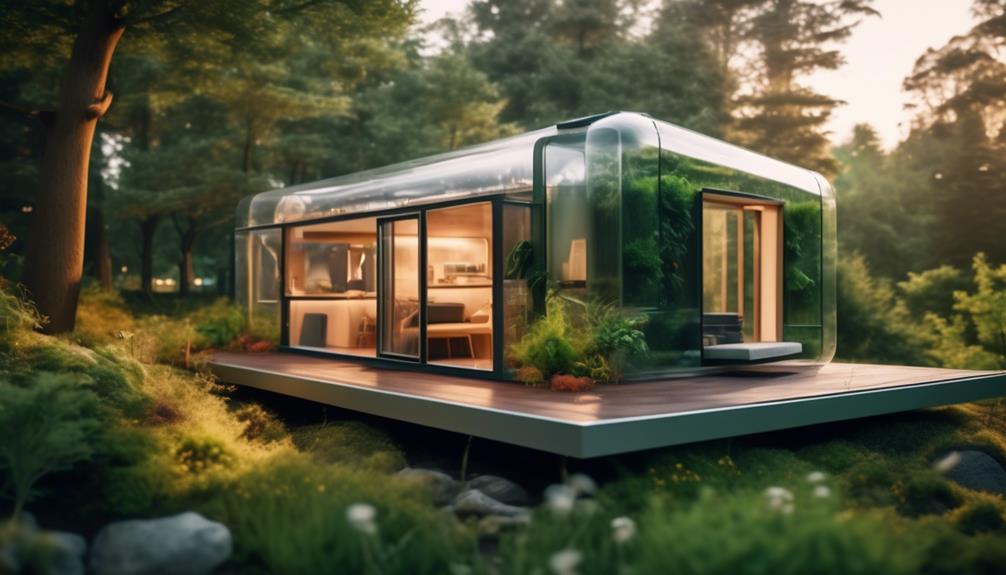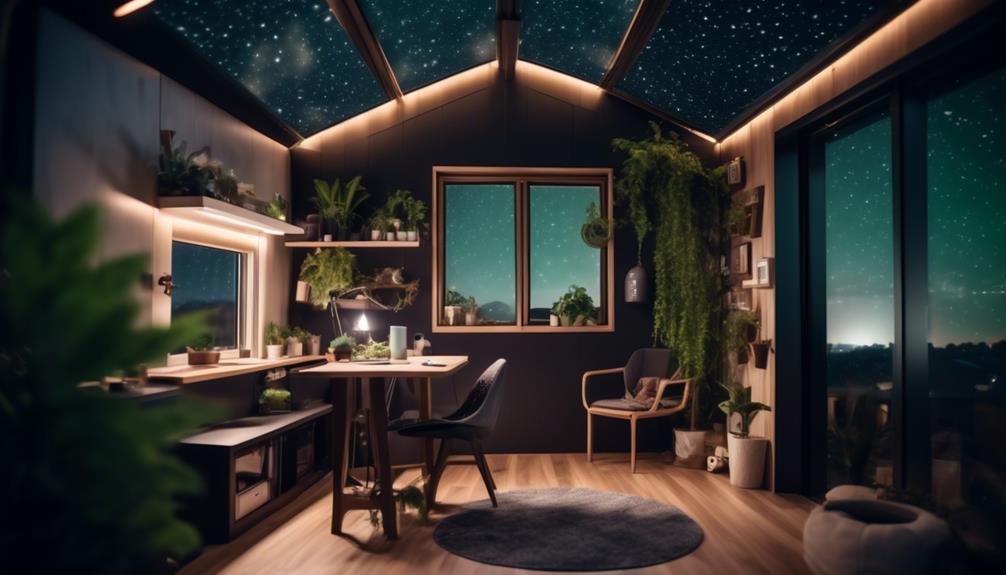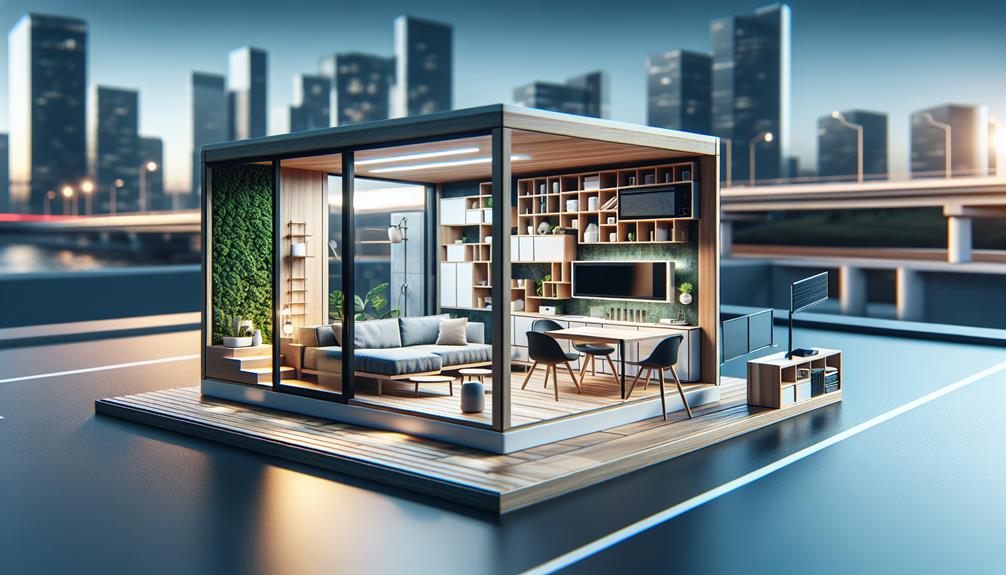Nearly 68% of tiny house owners have no mortgage, a stark contrast to the 29.3% of traditional homeowners who enjoy the same financial freedom.
You're likely familiar with the burgeoning trend of ultra-modern small homes, a movement that's redefining the American Dream for many. These compact abodes aren't just about downsizing square footage; they're about upgrading quality of life.
As you consider the possibility of joining this community, you may find yourself intrigued by the innovative design solutions that turn a limited space into a versatile, sustainable, and tech-savvy home.
But the real question is, how do these spaces function on a day-to-day basis for the people who live in them? As you ponder the potential shift from expansive living to embracing minimal square footage, the stories of those who've taken the plunge could provide a glimpse into a life that balances simplicity with modern luxury.
Key Takeaways
- Tiny living offers financial benefits, with a large percentage of tiny house owners having no mortgage compared to traditional homeowners.
- Maximizing space and style is crucial in tiny homes, and this can be achieved through outdoor areas, off-grid living solutions, and investing in comfort and functionality.
- Innovative design solutions, such as space-saving furniture and hidden storage, optimize square footage and allow for adaptable and multi-functional spaces in tiny homes.
- Tiny living promotes sustainability, with a focus on minimizing ecological footprint, integrating renewable energy sources, reducing waste, and utilizing sustainable materials in construction.
The Allure of Minimalist Living
Embracing minimalist living in a tiny house, you'll find that shedding excess possessions paves the way for a richer life centered around experiences and mindful consumption. The square footage is pretty low, yet this constraint fosters innovation in functional storage and adaptable spaces.
You'll learn to make sure that every item serves a purpose, cultivating an environment where quality trumps quantity. Energy-efficient appliances aren't just trendy—they're essential, optimizing your limited resources. Even though your abode is compact, the design must prioritize comfort and functionality, ensuring that contentment isn't sacrificed for simplicity.
Maximizing Space, Maximizing Style
In the realm of tiny living, every square inch counts. Residents are compelled to pair space-saving design with aesthetic appeal to create living environments that are as functional as they are stylish.
You're not just downsizing; you're strategically optimizing your habitat for maximum efficiency and charm.
Here's how:
- Outdoor Elegance: Integrate undercover areas and deck space, enhancing the utility and ambiance of your outdoor footprint.
- Sustainable Balance: Transition to off-grid living with solar solutions and energy-efficient appliances, but don't sever ties with grid energy—harmonize them.
- Interior Innovation: Invest in comfort and functionality. Think a plush new couch, a cozy fireplace, and a kitchen that marries energy efficiency with culinary delight.
These aren't mere changes; they're transformative steps towards an innovative, minimalist lifestyle that doesn't compromise on warmth or modernity.
Innovative Design Solutions

As you embrace tiny living, it's crucial to recognize how space-saving furniture concepts not only optimize square footage but also reflect your adaptability to compact living.
Multi-functional spaces demand thoughtful design, where every inch serves a purpose without sacrificing aesthetics or comfort.
Your ability to innovate within these constraints is a testament to the potential of tiny living as a solution to modern housing challenges.
Space-Saving Furniture Concepts
When living spaces shrink, innovative space-saving furniture becomes essential, offering multifunctionality and adaptability without sacrificing style or comfort. You're not just looking for a place to sit or sleep; you require pieces that transform along with your dynamic lifestyle.
Consider how:
- Foldable furniture can turn a home office into a dining room with ease.
- Hidden storage maximizes every square inch, allowing your possessions to disappear seamlessly into multifunctional structures.
- Modular systems provide the freedom to reconfigure layouts, accommodating your evolving needs and whims.
Your quest for a minimalist, clutter-free environment leads you to scrutinize each furniture choice critically. Every item must justify its footprint, merging aesthetics with practicality.
Embrace these innovative furniture concepts to navigate the challenges of tiny living with sophistication and ingenuity.
Multi-Functional Spaces Design
Building on the foundation of space-saving furniture, multi-functional space design pushes the boundaries of efficiency, turning each area of your tiny home into a versatile haven that caters to work, rest, and play with equal finesse.
| Feature | Functionality | Impact on Tiny Living |
|---|---|---|
| Outdoor Living | Undercover work areas, decks | Facilitates compact workspaces |
| Creative Storage | Durable kitchen design, pet spaces | Maximizes utility in minimal square footage |
| Compact Workspace | Energy-efficient, off-grid capable | Enhances productivity with sustainability |
You're tasked to rethink the conventional. Outdoor living isn't just for leisure; it's transformed into a compact workspace that's adaptable and resilient. Creative storage must not only hide clutter but also contribute to an environment that promotes well-being and functionality. Insightfully, these spaces reflect a critical shift towards a lifestyle that values experiences, fostering contentment within your compact, stress-free sanctuary.
The Sustainability Edge
Tiny living's sustainability edge becomes increasingly apparent as homeowners harness innovations like the 15 kW solar panel system and energy-efficient appliances to minimize their ecological footprint. By embracing sustainable construction, renewable energy, and eco-friendly materials, you're not just building a home; you're contributing to a healthier planet. Your choice to go tiny is a critical step toward a greener future.
Consider these pivotal benefits:
- Reduced Energy Consumption: The integration of solar panels and energy-efficient appliances cuts down on your reliance on fossil fuels.
- Minimalist Lifestyle: Embracing a tiny home encourages a life with fewer material possessions, leading to less waste.
- Eco-Friendly Building: Utilizing sustainable materials in your home's construction reduces the demand for resource-intensive products.
You're not just investing in a home; you're investing in the sustainability of our world.
Technological Features in Tiny Homes

As you consider the leap into tiny living, it's essential to recognize how technological advancements have revolutionized the functionality and sustainability of these compact spaces.
Solar panels and smart home systems have played a significant role in this transformation. Your tiny home can now harness solar power integration, not just for daily energy needs but also for charging electric vehicles—a critical step towards off-grid autonomy.
Inside the tiny home, energy-efficient appliances have become a necessity for conserving power and maximizing space. These appliances not only help in reducing energy consumption but also contribute to the overall sustainability of the dwelling.
Moreover, smart home technology has become integral in these dwellings. It allows for optimizing limited square footage through intelligent, space-saving solutions. Smart home technology isn't just a luxury in tiny homes; it's a practical and necessary tool for making the most out of the available space.
Embracing this conscious approach to technology transforms your tiny home into a model of efficient, sustainable living. It's not just about adding features; it's about critically rethinking resource use and making every square inch count.
Real-Life Tiny Living Experiences
Delving into the heart of tiny living, you'll find that the move towards a scaled-down space is less about sacrifice and more about embracing a lifestyle rich with unique experiences and personal growth. Adapting to minimalism isn't just about having fewer possessions; it's a critical shift towards finding contentment in what truly matters. Embracing simplicity becomes not just a design principle, but a holistic approach to life, redefining your needs and desires.
Outdoor space enhancements encourage connection with nature and personal well-being.
Interior updates reflect a commitment to both comfort and environmental consciousness.
Off-grid living is a deliberate choice for energy independence and reduced carbon footprint.
Innovation enthusiasts appreciate that tiny living is a multifaceted experience, fundamentally reshaping your interaction with your surroundings and self.
Frequently Asked Questions
Why Did Tiny House Nation Get Cancelled?
Tiny House Nation got cancelled due to production challenges, waning show popularity, and an audience shift seeking fresh content, signaling a critical need for innovation in TV that keeps pace with viewer evolution.
Can You Permanently Live in a Tiny Home?
You can live permanently in a tiny home, but you'll face zoning challenges. Adopting a minimalist lifestyle and a smart downsizing strategy is crucial for success in this innovative, space-efficient way of living.
What Are the 3 Negative Features of a Tiny House?
You'll find space limitations, minimal storage, and social challenges as key drawbacks of tiny houses, demanding innovative solutions to balance compact living with functional and social needs.
Is It Realistic to Live in a Tiny Home?
Yes, you can realistically live in a tiny home, like a hermit crab finding a shell that fits just right. Space-saving solutions and a minimalist lifestyle offset downsizing challenges, fostering innovative, sustainable living.
Conclusion
As you've journeyed through the realm of ultra-modern small homes, you've seen how less becomes more, and simplicity breeds innovation.
These compact abodes aren't just a trend; they're a testament to sustainable sophistication. Your exploration has unveiled the harmony between technological integration and minimalist ethos, proving that tiny living isn't just about space—it's about the essence of life distilled.
Embrace this architectural haiku, where every line, curve, and corner holds a purpose, and every nook cradles a story.

